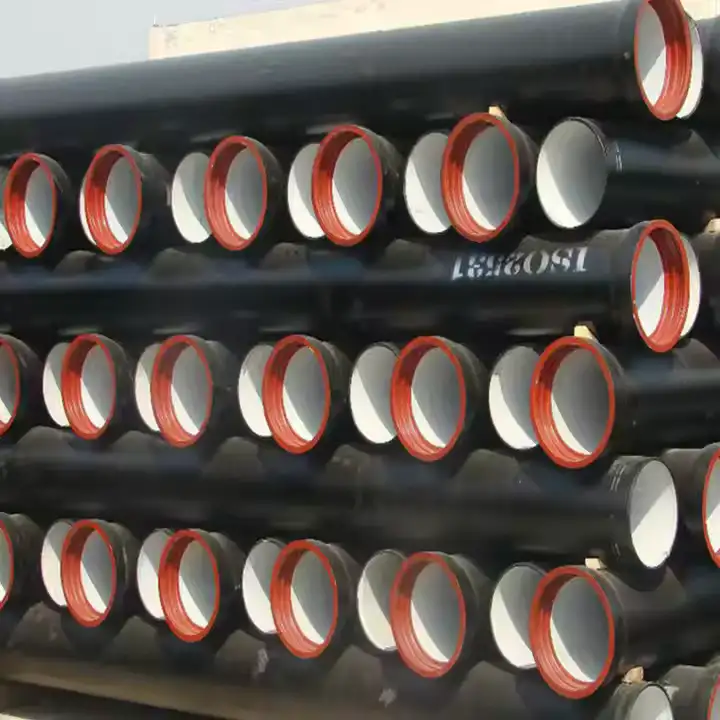Class K9 thickness for ductile iron pipes—one of the most common wall-thickness classifications under ISO 2531.Nominal diameter: 80 mm→1200 mm, they are available in nominal thickness between 6mm to 15.3mm.

What Is Class K9?
Class K9 is a wall-thickness class defined in the ISO 2531 standard for ductile iron pipes, where “K” classes categorize pipes by nominal wall thickness rather than by allowable pressure. The K9 designation specifies a particular series of nominal thicknesses that increase with pipe diameter, ensuring consistent mechanical and hydraulic performance across sizes.
K-Class vs. C-Class Overview
ISO 2531 groups ductile iron pipes into two main families:
-
K classes (K7, K8, K9, etc.), which are strictly based on nominal wall thickness.
-
C classes (C25, C30, C40, etc.), which are defined by working pressure ratings and correspond to preferred thicknesses for specific hydraulic pressures.
Choosing between them depends on project requirements: K classes offer straightforward thickness selection by diameter, while C classes ensure rated pressure performance.
Class K9 Thickness Table
| Nominal Diameter (DN) | External Diameter (DE) | Nominal Wall Thickness (K9) |
|---|---|---|
| 80 mm | 98 mm | 6.0 mm |
| 100 mm | 118 mm | 6.0 mm |
| 150 mm | 170 mm | 6.0 mm |
| 200 mm | 222 mm | 6.3 mm |
| 250 mm | 274 mm | 6.8 mm |
| 300 mm | 326 mm | 7.2 mm |
| 350 mm | 378 mm | 7.7 mm |
| 400 mm | 429 mm | 8.1 mm |
| 450 mm | 480 mm | 8.6 mm |
| 500 mm | 532 mm | 9.0 mm |
| 600 mm | 635 mm | 9.9 mm |
| 700 mm | 738 mm | 10.8 mm |
| 800 mm | 842 mm | 11.7 mm |
| 900 mm | 945 mm | 12.6 mm |
| 1000 mm | 1048 mm | 13.5 mm |
| 1100 mm | 1152 mm | 14.4 mm |
| 1200 mm | 1255 mm | 15.3 mm |
Source: Electrosteel Castings Ltd. ISO 2531 dimensions & thickness table.
Factors Influencing Thickness Selection
-
Hydraulic Requirements: Larger flow rates may require thicker walls to maintain structural integrity under internal pressure.
-
External Loads: Burial depth, soil type, and live loads (traffic, machinery) can dictate a heavier wall.
-
Corrosion Allowance: In aggressive soils or fluids, extra thickness may be specified for long-term durability.
-
Jointing System: Some restrained-joint designs impose specific thickness minima to accommodate mechanical inserts.
Common Applications
-
Potable Water Distribution: K9 pipes frequently serve urban drinking-water mains due to their balance of flow capacity and structural robustness.
-
Sewage & Drainage: The thicker walls handle negative pressures and external soil loads in wastewater systems.
-
Irrigation Networks: K9’s consistent thickness makes it ideal for high-volume agricultural water conveyance.
-
Industrial Piping: Chemical plants and cooling systems benefit from K9’s mechanical strength and corrosion resistance.
FAQ
Q1: Is Class K9 suitable for high-pressure service?
A1: K9 is rated for nominal working pressures up to approximately 16 bar (depending on diameter and joint type), but for guaranteed pressure ratings, C-class pipes (e.g., C 40) are often preferred.
Q2: Can I use K9 pipes under roadways?
A2: Yes—provided the design accounts for axle loads and the trench engineering matches local standards. The higher wall thickness of K9 improves load resistance.
Q3: How does K9 compare to K7 or K8?
A3: K9 offers thicker walls than K7 and K8 for the same diameter, thus higher stiffness and pressure capacity, but at increased material cost.
Q4: Are K9 pipes compatible with existing fittings?
A4: They use standard ISO 2531 joint designs (push-on, mechanical, or flanged), so they interconnect with other K-class pipes of matching DE and joint type.
References:
- ISO 2531:2009 – Ductile iron pipes, fittings, accessories and their joints for water applications
- Electrosteel – Ductile Iron Pipe Specifications including K9 Thickness Chart
- Wikipedia – Ductile Iron Pipe: Classifications and Wall Thickness
- Ductile Iron Pipe Research Association (DIPRA) – Pipe Specifications & Class Descriptions
- ISO/TC 5/SC 2 – Cast iron pipes, fittings and their joints technical committee

